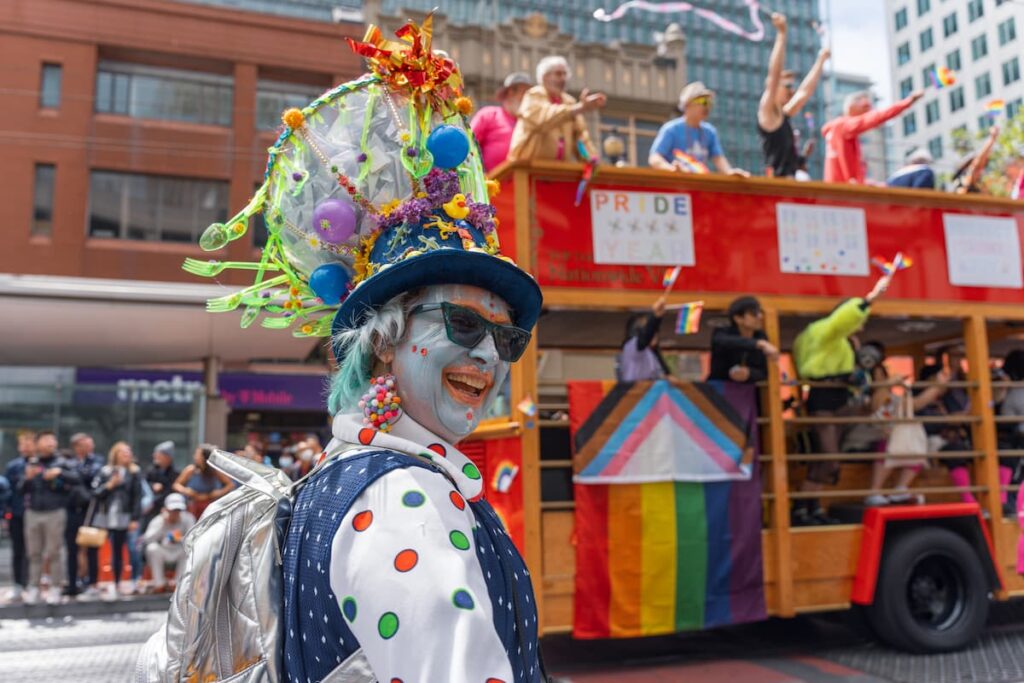A Neighborhood, a Flag, a Revolution
In 1965, Life magazine declared San Francisco the capital of gay America—and at its heart was the Castro.
Perhaps the most iconic “gayborhood” in the United States, the Castro became home to some of the most influential queer artists, activists, and visionaries of the 20th century. It was here that the Pride flag was born, the first openly gay male politician was elected, and countless LGBTQ individuals—often rejected by their families—found community and built chosen families.
Before its queer renaissance, the area was known as Eureka Valley or “Little Scandinavia.” But during the social upheaval of the 1960s—with anti-war protests and the rise of the hippie movement—young people flocked to San Francisco, seeking freedom.
“The Castro neighborhood became famous for its incredible welcoming of LGBTQ people,” says Roberto Ordeñana, executive director of the GLBT Historical Society. “And I think that was built through word of mouth.”
Founded in 1985 during the height of the AIDS crisis, the Historical Society has worked to preserve LGBTQ history through memorabilia, zines, and artifacts—including the original rainbow Pride flag.
Harvey Milk: Icon and Martyr
The most visible symbol of the American LGBTQ rights movement remains Harvey Milk. Born in New York, Milk moved to San Francisco in 1972 and opened a camera shop on Castro Street—the neighborhood’s central artery.
Milk quickly became politically active, founding the Castro Village Association, one of the nation’s first LGBTQ-owned business alliances. His activism earned him the nickname “Mayor of Castro Street,” a title given by his biographer, Randy Shilts.
In 1977, Milk was elected to San Francisco’s Board of Supervisors, making history as the first openly gay man elected to public office in the U.S. He played a key role in defeating Proposition 6, a proposed law that would have allowed schools to fire openly gay teachers.
“Milk crystallized the political hopes and dreams of a generation of out gay people,” says Timothy Stewart-Winter, a Rutgers University historian specializing in LGBTQ history.
Tragically, less than a year after taking office, Milk was assassinated—along with Mayor George Moscone—by a fellow city supervisor, Dan White.
His death elevated him to martyr status. “Like JFK and Martin Luther King Jr., Milk became frozen in history during a time of great social upheaval,” says Stewart-Winter.
Milk’s legacy lives on. In 2019, the U.S. Navy named a ship after him—a poignant gesture, considering Milk had been forced to resign from the Navy due to his sexuality. San Francisco International Airport also named a terminal in his honor.
Still, Ordeñana warns against focusing only on Milk’s legacy. “We need to celebrate Harvey Milk, but also other incredible figures like Sally Gearhart, who fought alongside him against Proposition 6 and helped build women’s studies programs. Too many stories have been left out of the mainstream narrative.”
A Symbolic Neighborhood Facing Real Change
Today, the Castro still hosts vibrant street fairs and remains a global LGBTQ destination. But some argue it has also become a victim of its own success.
“It’s a place where people go to be gay. But it’s also a place where housing is unaffordable and the contradictions of late capitalism play out,” says Stewart-Winter.
The tech boom has dramatically changed San Francisco, and the Castro is no exception. As far back as the 1990s, high-end retailers like Diesel opened storefronts on Castro Street. Now, Apple and Starbucks sit alongside family-owned taquerias and independent art galleries.
Yet the past remains visible. Milk’s former camera shop at 575 Castro Street is a city landmark, marked with a commemorative plaque and mural.
To keep LGBTQ history alive and accessible, the GLBT Historical Society recently raised enough funds to secure a permanent museum location in the neighborhood.
“LGBTQ people live everywhere. We are part of every neighborhood, every community. But the Castro remains a destination for people from around the world,” says Ordeñana. “That’s why it was important to have a museum here—so visitors and locals alike can learn, remember, and celebrate.”
“I was born and raised in San Francisco,” he adds. “I never left. I love traveling the world, but this is home.”


